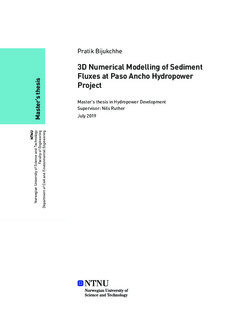| dc.description.abstract | The purpose of this thesis was to setup a three-dimensional numerical model on SSIIM 2
for the peaking pond of the Paso Ancho Hydropower Project. Not limited to numerical
model, failure reasons for the desander is also studied. The main aim of the numerical
model is to obtain the distribution of bed sediment in the pond and compare with the
data from the field.
The peaking pond has severe sediment problem due to the poor efficiency of the
desander located at the headworks. All the sediments entering through the intake passes
through the desander and enter in to the pond. This has led to loss of capacity of the
pond and extra financial cost for implementation of different sediment removal methods.
At present, 200mm dredge installed by SediCon is removing the sediments from the
pond. It was installed in August 2018 and by January 2018 had removed around
14458m3 volume of sediments. The total capacity of pond is 70000m3.
A survey was done by Acoustic Doppler Current Profiler (ADCP) to obtain the bathymetry
and velocity profile of the peaking pond. Sediment samples from the bed of the pond was
analyzed in the lab to obtain the grain size distribution of the samples. The discharge in
river was measured to obtain the inflow in the pond. These field data are compared with
the results from the SSIIM model.
A three-dimensional numerical model has been setup to perform hydraulic and sediment
transport simulation. A first model is setup with the measured discharge and surveyed
geodata to perform a water flow simulation. The obtained velocity magnitude is
compared with the surveyed velocity profile data. The hindrance most encountered was
in shaping the inflow structure for the peaking pond to imitate the same flow pattern as
actual in the site. The model showing similar pattern of flow is chosen and two additional
cases of water flow simulation are performed which later is used for sediment transport
simulation. Second model is run with the higher discharge corresponding to the discharge
of wet season at which the pond receives high sediment inflow. And third model is run
again on the higher discharge but the geodata of original geometry of the pond is used,
which has no sediment deposition. The second and third cases of water flow simulation
are used to the run the sediment transport simulation. From the sediment simulation, the
bed grain size distribution is obtained and compared with the sediment samples taken
from the pond.
Number of changes to the geometry and location of the inflow were done and different
algorithms and parameters were used simultaneously to produce a likely result. The
result showed similar flow patterns but different bed sediment distribution when
comparing with the field data. There are still uncertainties concerning the input data,
geometry of inflow and outflow. The sediment deposition and distribution pattern in
pond is affected by the daily fluctuation of water level in the pond. There is a daily
lowering down of water level to the lowest possible operation level since this is a daily
peaking type project and has different inflow and outflow discharge. The numerical model
is run in the scenario assumed that in the wet season, when discharge is high in the
river, the level of water at the pond is maintained at constant normal water level
throughout the day and has an equal inflow and outflow discharge.
To conclude, the model requires more calibration and validation from the field data and
further work on the geometry of model is also recommended to use the model for the
prediction of sediment distribution. | |
